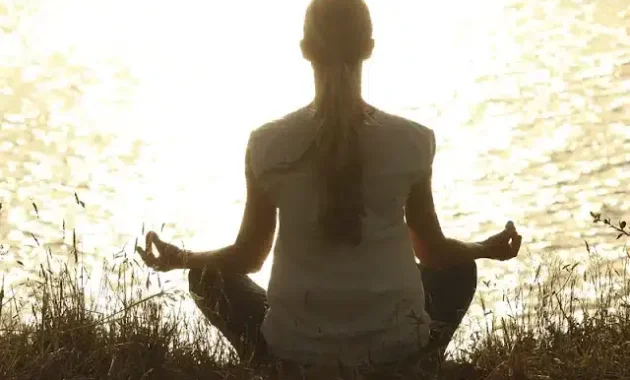Yin Yoga is a style of yoga that emphasizes slow, passive stretches held for several minutes at a time. Unlike other styles of yoga that focus on muscular strength and endurance, Yin Yoga targets the body’s deep connective tissues, such as the fascia, bones, and joints.
The origins of Yin Yoga can be traced back to Taoist Yoga and Qigong practices in ancient China. It was later popularized in the West by Paulie Zink, a martial arts master and yoga teacher, who incorporated the principles of Yin Yoga into his practice.
What is Yin Yoga?
Yin Yoga is a type of yoga practice that focuses on the connective tissues in the body, such as the tendons, ligaments, and fascia. It is a slow-paced, meditative practice emphasizing the body’s stillness in each pose.
The Balance of Yin and Yang
The philosophy of Yin Yoga is rooted in the Taoist concept of balance between yin and yang. The yin aspect represents stillness, rest, and introspection, while the yang aspect represents movement, action, and exertion. In Yin Yoga, we cultivate balance by spending time in still, passive poses that target the body’s deep tissues.
Longer Holds, Slower Poses
The characteristics of Yin Yoga include longer holds of each pose, usually ranging from 2 to 5 minutes. The poses are also slower, focusing on mindful breathing and relaxation. This approach helps increase flexibility and range of motion while promoting calm and inner peace.
The Benefits of Yin Yoga
Are you looking for a way to improve your physical and mental well-being? Look no further than Yin Yoga! The benefits of Yin Yoga include:
1. Improved Flexibility and Joint Health
One of the main physical benefits of Yin Yoga is improved flexibility. Holding poses for longer periods gives your muscles and joints a chance to stretch and release any tightness. It can improve mobility, reduce pain and discomfort, and better posture.
2. Reduced Stress and Improved Focus
Yin Yoga also has numerous mental health benefits. Practicing Yin Yoga can help reduce stress and anxiety levels by slowing down the mind and calming the nervous system. It can also help improve focus and concentration and increase mindfulness and self-awareness.
3. Greater Inner Peace and Emotional Well-being
In addition to its physical and mental benefits, Yin Yoga can also bring spiritual benefits to those who practice it. You can experience a greater sense of inner peace and emotional well-being by quieting the mind and connecting with the breath. It can lead to a deeper connection with the self and a greater understanding of your place in the world.
Yin Yoga Poses
In this section, we will dive into the heart of Yin Yoga and explore the different poses that make up this practice. Whether you’re new to yoga or a seasoned practitioner, we’ve covered you with beginner, intermediate, and advanced poses to suit every level.
We will also cover modifications and variations to make the poses accessible to everyone, regardless of flexibility or experience. Get ready to stretch, release tension, and connect with your body and mind as we dive into Yin Yoga poses!
A. Beginner Poses
- Child’s Pose: This pose is a gentle stretch for the lower back and hips, making it a great starting point for those new to Yin Yoga. To get into a child’s pose, start on your hands and knees with your big toes touching and sit back onto your heels.
- Butterfly: This pose is great for opening up the hips and stretching the inner thighs. To get into a butterfly, sit on the floor with the soles of your feet together and gently bring your heels towards your body.
- Caterpillar: This pose is great for stretching the spine and the back of the legs. To get into the caterpillar, sit on the floor with your legs extended out in front of you and slowly fold forward from the hips, reaching towards your toes.
B. Intermediate Poses
- Sphinx: This pose is great for stretching the spine and the front of the body. To get into sphinx, start lying on your stomach with your forearms on the floor and lift onto your elbows, keeping your gaze forward.
- Pigeon: This pose stretches the hips, groin, and inner thighs. To get into the pigeon, start in a downward-facing dog and bring one knee forward towards your hand, keeping the other leg extended behind you.
- Lizard: This pose is great for stretching the hips and front legs. To get into the lizard, start in a downward-facing dog and bring one foot to the outside of the same-side hand, keeping the other leg behind you.
C. Advanced Poses
- Frog: This pose is great for stretching the hips and the inner thighs. To get into the frog, start on your hands and knees with your wrists under your shoulders and your knees under your hips.
- Dragon: This pose is great for stretching the hips and front legs. To get into the dragon, start in a lunge position with one leg forward and one leg back, and bring your front knee down to the floor, keeping your back leg extended behind you.
- Half Lotus: This pose is great for stretching the hips and the legs. To get into half lotus, start seated with one ankle resting on the opposite thigh.
D. Modifications and Variations, Making the Poses Accessible for Everyone
For those who may find some poses too difficult, some modifications can be made to make the poses more accessible. For example, props such as blocks or blankets can help support the body and make the poses more comfortable.
There are also variations of the poses that can be explored for those looking for a deeper stretch. For example, using movement in the pose or holding the pose for longer can add an extra challenge to the practice.
By incorporating these beginner, intermediate, and advanced poses into your practice, you can experience the many benefits of Yin Yoga and deepen your connection with your body, mind, and soul.
How to Start Practicing Yin Yoga
Starting your Yin Yoga practice with a class or teacher can be a great way to get familiar with the poses and philosophy of Yin Yoga. Look for a studio or teacher specializing in Yin Yoga, as this will ensure you receive proper instruction and guidance. Practicing in a group setting can also be a fun and motivating experience, and you may make new friends along the way.
If you prefer to practice in the comfort of your own home, setting up a Yin Yoga practice can be easy and convenient. You will need a yoga mat and some props, such as blankets, blocks, and straps, to help you get into the poses. You can also invest in a foam roller or a yoga bolster for support.
When starting your Yin Yoga practice, it’s important to approach each pose with patience and mindfulness. Remember to breathe deeply and stay in each pose for a few minutes, allowing your muscles to relax and release. It’s also helpful to incorporate meditation and mindfulness practices into your routine, such as deep breathing and visualization exercises, to enhance the mental and spiritual benefits of Yin Yoga.
Conclusion
In conclusion, Yin Yoga is a slow-paced and meditative form of yoga that offers numerous physical, mental, and spiritual benefits. From improving flexibility and joint health to reducing stress and promoting emotional well-being, the benefits of Yin Yoga are vast and profound.
With a regular Yin Yoga practice, you’ll experience greater inner peace, improved focus, and a deeper connection to your body, mind, and soul. So, why not try it today and see how it can transform your life?


